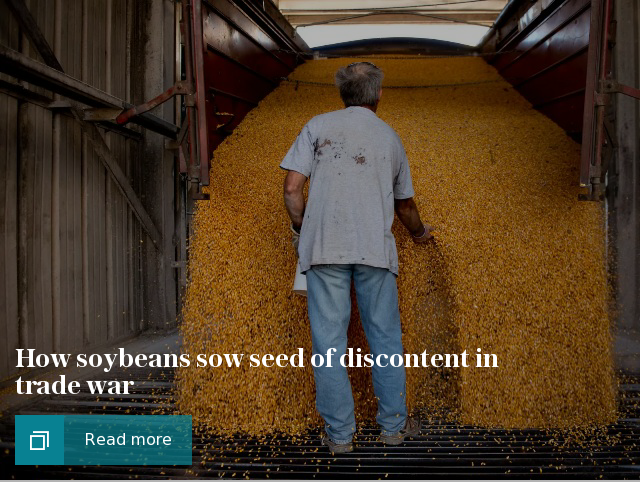China hits back as US escalates trade war with new $200 billion tariff list

The Trump administration pushed ahead with plans to impose tariffs on additional $200 billion in Chinese products by releasing a list of targets, marking a sharp escalation in a trade war between the world’s two largest economies.
Orrin Hatch, the Republican Senate Finance Chairman, condemned the move as “reckless” and not “targeted”, while the uneasy calm that had descended on Asian markets was shattered.
Items on the proposed list of goods include consumer products such as clothing, television components and refrigerators as well as other high-tech items, but it omitted some high-profile products like mobile phones.
The tariffs could take effect after public consultations end on August 30, according to a statement from the US Trade Representative’s office on Tuesday.
The US said it had no choice but to move forward on the new tariffs after China failed to respond to the administration’s concerns over unfair trade practices and Beijing’s abuse of American intellectual property, according to two senior officials. High-level talks between the two countries starting in May failed to deliver a breakthrough to head off a trade war.

“For over a year, the Trump administration has patiently urged China to stop its unfair practices, open its market, and engage in true market competition,” Robert Lighthizer, the US Trade Representative, said.
“Unfortunately, China has not changed its behaviour - behaviour that puts the future of the US economy at risk. Rather than address our legitimate concerns, China has begun to retaliate against US products. There is no justification for such action.”
Reacting to the "totally unacceptable" Washington list, the commerce ministry in Beijing said it would be forced to take "countermeasures".
"The behaviour of the US is hurting China, hurting the world, and hurting itself," the ministry said in a statement, saying it was "shocked" by the US actions.
"In order to safeguard the core interests of the country and the fundamental interests of the people, the Chinese government as always will have no choice but to take the necessary countermeasures," it added.
Beijing said it would "immediately" tack on the case to its suit against Washington's "unilateralist" behaviour at the World Trade Organisation.
While observers have been nervously expecting the next salvo in the trade row, the news jarred markets, which had enjoyed some stability this week from upbeat US jobs data and hopes for the upcoming earnings season.

MSCI's broadest index of Asia-Pacific shares outside Japan fell 1.1 percent, Hong Kong's Hang Seng slid 1.5 percent and the Shanghai Composite Index dropped 1.8 percent. South Korea's KOSPI lost 0.55 percent and Japan's Nikkei fell 1 percent.
Spreadbetters expected the Asian gloom to extend to European stocks, with Britain's FTSE tipped to open down 0.45 percent, Germany's DAX 0.6 percent and France's CAC 0.5 percent.
S&P 500 and Dow futures were down 0.7 percent and 0.75 percent, respectively, pointing to a lower open for Wall Street later in the day.
"The markets still remain sensitive to the trade-related theme, which is something investors have to take into account for the long term," said Yoshinori Shigemi, global market strategist at JPMorgan Asset Management in Tokyo.
"At the same time, the trade dispute can easily be blamed for a variety of ills. But it could mask over factors that could also weigh on equities in the longer run, such as tighter monetary policies led by the United States."
The Trump administration on July 6 imposed 25 percent duties on $34 billion in Chinese imports, the first time the president has implemented tariffs directly on Beijing after threatening to do so for months. The first round of tariffs covered Chinese products ranging from farming plows to machine tools and communications satellites.

China immediately retaliated with duties on the same value of US goods, including soybeans and cars.
In addition, the US is considering separate duties on a further $16 billion in Chinese goods, after a public hearing later this month. China has vowed to retaliate dollar-for-dollar to any further US tariffs.
The International Monetary Fund has warned that a full-blown trade war could undermine the broadest global upswing in years. But Mr Trump hasn’t backed down, arguing that China’s unfair trading practices are hurting American workers.

The president last month asked the US Trade Representative’s office to identify $200 billion of Chinese goods that could be hit with 10 percent tariffs. Since then, the president has said his administration could impose duties on virtually all Chinese imports into the US.
Mr Trump has been considering tariffs against China since his officials concluded in March that Beijing violates US intellectual-property rights, such as by forcing American firms to hand over technology.
The initial US tariff list focused on Chinese industrial products in an attempt to limit the impact on American consumers. By expanding the list, the administration is beginning to hit products that US households buy, including such things as electric lamps and fish sticks.
"Tariffs on $200 billion in Chinese products amounts to another multibillion-dollar tax on American businesses and families," said Scott Lincicome, a trade lawyer and senior policy analyst for the group Republicans Fighting Tariffs. "Given China's likelihood of retaliation, it's also billions worth of new tariffs on American exporters."

 Yahoo Finance
Yahoo Finance 